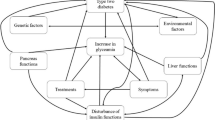Abstract
University students increasingly use hypertextto write their assignments. To employ hypertexteffectively, more information about thehypertext authoring process is needed. Thereare features of hypertext which are notreflected in traditional theories ofcomposition, especially the possibility tostructure information visually. Our studyindicates that graphical overview maps whichcan be edited are a rather attractive featureof hypertext authoring systems. Nevertheless,not all students profit from such features.Students employ different writing styles whenthey create hypertext documents. The majorityof students experiments with hypertext's newfeatures but others are still influenced by themodel of the book.
Similar content being viewed by others
References
Bereiter C., Scardamalia M. (1987) The Psychology of Written Composition. Hillsdale, NJ: Lawrence Erlbaum.
Bolter J.D. (1991) Writing Space. The Computer, Hypertext, and the History of Writing. Hillsdale, NJ: Lawrence Erlbaum.
Bonhoff U.M. (1993) Das Diagramm. Kunsthistorische Betrachtung über seine vielfältige Anwendung von der Antike bis zur Neuzeit. Münster (Dissertation).
Buchanan R., Margolin V. (eds.) (1995) Discovering Design: Exploration in Design Studies. Chicago: University of Chicago Press.
Chen C. (1999) Visualising Semantic Spaces and Author Co-Citation Networks in Digital Libraries. Information Processing and Management, 35(3), pp. 401–420.
Chen C., Czerwinski M. (1997) Spatial Ability and Visual Navigation: an Empirical Study. The New Review of Hypermedia and Multimedia, 3, pp. 67–89.
Eysenck M.W., Keane M.T. (1990) Cognitive Psychology-A Student's Handbook. Lawrence Erlbaum, Hove and London, UK.
Fisher K. (1992) SemNet: A Tool for Personal Knowledge Construction. In Kommers P.A., Jonassen D.H., Mayes J.T. (eds.), Cognitive Tools for Learning. Springer, Berlin, Heidelberg, New York, pp. 63–75.
Flower L., Hayes J.R. (1980) The Dynamics of Composing: Making Plans and Juggling Constraints. In Gregg L.W., Steinberg E.R. (eds.), Cognitive Processes in Writing. Lawrence Erlbaum, Hillsdale, NJ, pp. 31–50.
Handler P. (1997) Stileigenschaften elektronisch vermittelterWissenschaftstexte. In Knorr D., Jakobs E.-M. (eds.), Textproduktion in elektronischen Umgebungen. Peter Lang, Frankfurt/Main.
Hartley J. (1992) Technology and Writing. Readings in the Psychology of Written Communication. Jessica Kingsley Publishers, London and Philadelphia.
Hayes J.R. (1996) A New Framework for Understanding Cognition and Affect in Writing. In Levy C.M., Ransdell S. (eds.), The Science of Writing. Theories, Methods, Individual Differences and Applications. Mahwah NJ: Lawrence Erlbaum, pp. 1–27.
Hayes J.R., Flower L. (1980) Identifying the Organization of Writing Processes. In Gregg L.W., Steinberg E.R. (eds.), Cognitive Processes in Writing. Lawrence Erlbaum, Hillsdale, NJ, pp. 3–30.
Hayes J.R., Nash J.G. (1996) On the Nature of Planning in Writing. In Levy C.M., Ransdell S. (eds.), The Science of Writing. Theories, Methods, Individual Differences and Applications. Lawrence Erlbaum, Mahwah, NJ, pp. 29–55.
Jonassen D., Beissner K., Yacci M. (1993) Structural Knowledge. Techniques for Representing, Conveying, and Acquiring Structural Knowledge. Lawrence Erlbaum, Hillsdale, NJ, Hove and London.
Kaplan N., Moulthroup S. (1994) Where no Mind Has Gone Before. Ontological Design for Virtual Spaces. ECHT' 94 Proceedings, ACM European Conference on Hypermedia Technology, pp. 206–216
Kellog R.T. (1992) Designing Idea Processors for Document Composition. In Hartley J. (ed.), Technology and Writing. Readings in the Psychology of Written Communication. Jessica Kingsley Publishers, London, Philadelphia, pp. 181–199.
Kommers P.A.M., de Vries S.A. (1992) TextVision and the Visualisation of Knowledge: School-based Evaluation of its Acceptance at two Levels of Schooling. In Kommers P.A., Jonassen D.H., Mayes J.T. (eds.), Cognitive Tools for Learning. Berlin, Heidelberg. Springer, New York, pp. 33–62.
Kozma R.B. (1992) Constructing Knowledge with Learning Tool. In Kommers P.A., Jonassen D.H., Mayes J.T. (eds.), Cognitive Tools for Learning. Berlin, Heidelberg. Springer, New York, pp. 23–32.
Kress G., van Leeuwen T. (1996) Reading Images. The Grammar of Visual Design. Routledge, London, New York.
Maeda J. (2001) Maeda @ Media. Universe Books, New York.
Manovich L. (2001) The Language of New Media. Cambridge, MA: MIT Press.
Marshall C.C, Shipman F.M., Coombs J.H. (1994) VIKI: Spatial Hypertext Supporting Emergent Structure. Proceedings of the European Conference on Hypermedia Technologies, Edinburgh, Scotland, pp. 13–23.
Marshall C.C, Shipman F.M. (1997) Spatial Hypertext and the Practice of Information Triage. Proceedings of the Hypertext '97, Southhampton, UK, pp. 124–133.
McEneaney J.E. (1999) Visualizing and Assessing Navigation in Hypertext. Proceedings of the Hypertext '99 Conference, ACM, New York, pp. 61–70.
McEneaney J.E. (2000) Navigational Correlates of Comprehension in Hypertext. Proceedings of the Hypertext '00 conference, ACM, New York, pp. 254–255.
Nelson T. (1992) Literary Machines 93.1. Mindful Press, Sausalito, CA.
Pohl M., Purgathofer P., Prenner P. (1995) Hypermedia in Education-Monitoring the Development of Hypermedia. Psychology Teaching Review, 4(2), pp. 142–152.
Pohl M., Purgathofer P. (2000). Hypertext Authoring and Visualisation. International Journal of Human-Computer Studies (Special Issue on Information Visualisations), 53(5), pp. 809–825.
Reader, W. Hammond, N. (1994) Computer-Based Tools to Support Learning from Hypertext: Concept Mapping Tools and Beyond. Computers Educ., 22, pp. 99–10.
Schriver K.A. (1997) Dynamics of Document Design. John Wiley, New York, Chichester, Brisbane.
Sharples M. (1992) Computers and Writing. Issues and Implementations. Kluwer, Dordrecht, Boston, London.
Sharples M. (1996) An Account of Writing as Creative Design. In Levy C.M., Ransdell S. (eds.), The Science of Writing. Theories, Methods, Individual Differences, and Applications. Lawrence Erlbaum, Mahwah, NJ, pp. 127–148.
Waes L. van (1992) The Influence of the Computer on Writing Profiles. In Maat H.P., Steehouder M. (eds.), Studies of Functional Text Quality. Rodopi, Amsterdam.
Waes L. van, Schellens P.J. (1998) Writing Profiles. The Effect of the Word Processor on Pausing and Revision Patterns. Working Paper 98/261, UFSIA, University of Antwerp, Department of Business Economics.
Winograd T., Flores F. (1989) Erkenntnis Maschinen Verstehen. Rotbuch Verlag, Berlin.
Author information
Authors and Affiliations
Rights and permissions
About this article
Cite this article
Pohl, M., Purgathofer, P. Hypertext Writing Profiles and Visualisation. Computers and the Humanities 38, 83–105 (2004). https://doi.org/10.1023/B:CHUM.0000009226.51168.47
Issue Date:
DOI: https://doi.org/10.1023/B:CHUM.0000009226.51168.47




